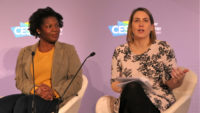CES 2020: Innovation Policy and Readiness For 5G Future
January 8, 2020
CTA senior vice president, political and industry affairs Tiffany Moore introduced a panel on 5G as the first in a series of CES panels focusing on innovation policy. Pete Hoekstra, the U.S. State Department’s ambassador to the Netherlands introduced a governmental perspective. “We want an open, global competitive market for 5G that functions under the rule of law and is a framework we can trust,” he said. “We need to get government to work collaboratively with industry to update rules and regulations.”
“There’s a huge opportunity for public-private partnerships,” continued Hoekstra. In the ensuing panel discussion, Verizon associate general counsel, emerging technologies Melissa Tye (below right) noted that 5G “is not just about downloading movies faster.”
“We’re seeing entertainment in Los Angeles and media and finance in New York City benefitting,” she said. “It can also enable tools for accessibility, telemedicine and haptics.”

Doctor on Demand director of policy and government affairs Latoya Thomas (above left) picked up on Tye’s mention of health and accessibility. “5G can help all kinds of people,” she said. “Eighty-six percent of Medicare recipients have a smartphone and 69 percent own tablets, which allows them to manage their own healthcare. Last year, Doctor on Demand partnered with Humana and Walmart to offer a primary care benefit.”
Samsung Electronics senior vice president of public policy John Godfrey noted that Verizon is one of his company’s customers for 5G base stations. “On the handset side we sold 6.7 million 5G phones worldwide and to all the U.S. carriers,” he added.
The discussion quickly turned to 5G frequencies. Verizon, said Tye, has launched on millimeter wave, but has future plans for “launching on all the frequencies.” “We said we would hit 30 cities by the end of 2019, and we hit 31,” she said. “For 2020, our goal is to reach 50 percent of the population in the U.S., and I’m confident we’ll do it.”
Intel executive director, communications policy Jayne Stancavage brought up the fact that low-band and mid-band spectra have “different capabilities and characteristics.” “As a chipmaker, we have to support many bands,” she said. “We have to support not just different frequencies but also different use cases.”
Tye noted “C-Band and 6GHz are also on our radar screen, but mid-band is where our focus is.” She also said that, “it’s important that a [spectrum] auction happens this year.” Stancavage, who said Intel is also “laser-focused on the mid-band frequency,” agreed. The speakers also expressed interest in low-band frequencies, but Stancavage noted that, “we need access to the spectrum and the regulatory infrastructure in place to allow it to happen.”
“If you can build radio components and digital processing components to work in countries around the world, that creates economies of scale,” said Godfrey, echoing some of Stancavage’s statements. “The 3GPP is developing the 5G standards, and it’s those global standards that are making 5G possible so your phone will talk anywhere in the world.”

No Comments Yet
You can be the first to comment!
Sorry, comments for this entry are closed at this time.